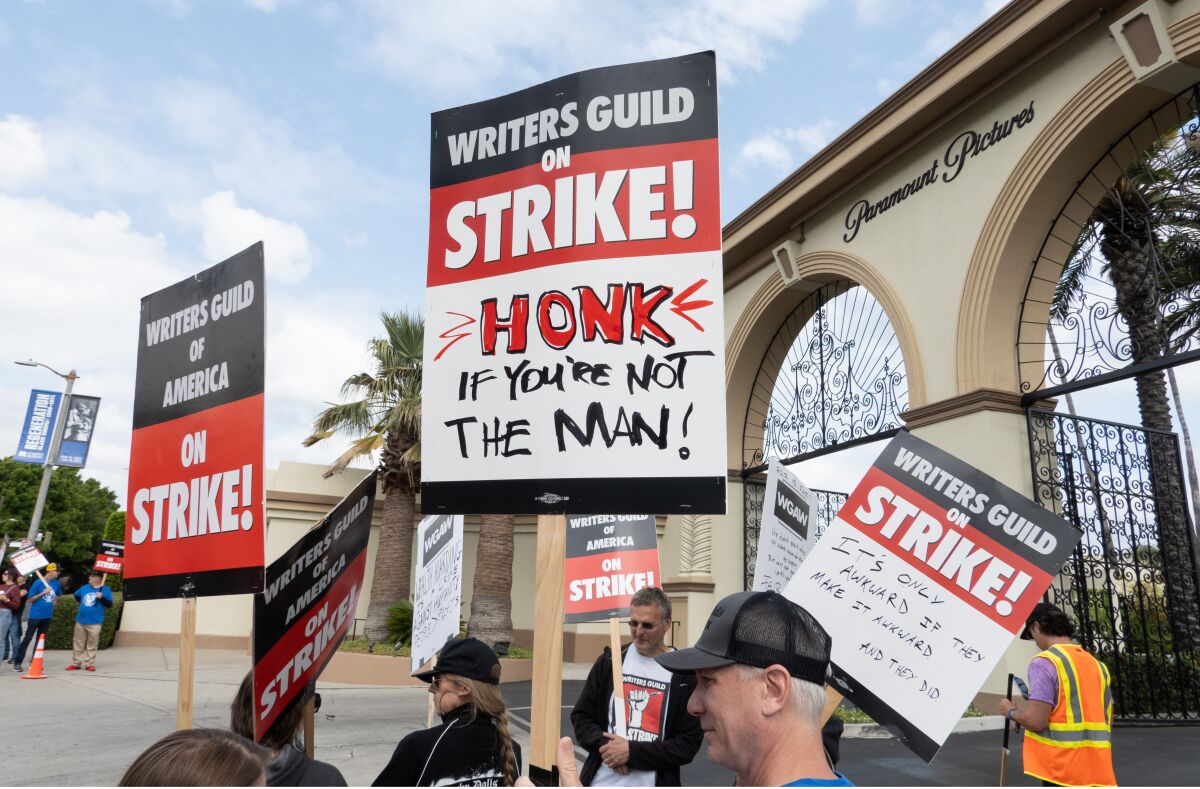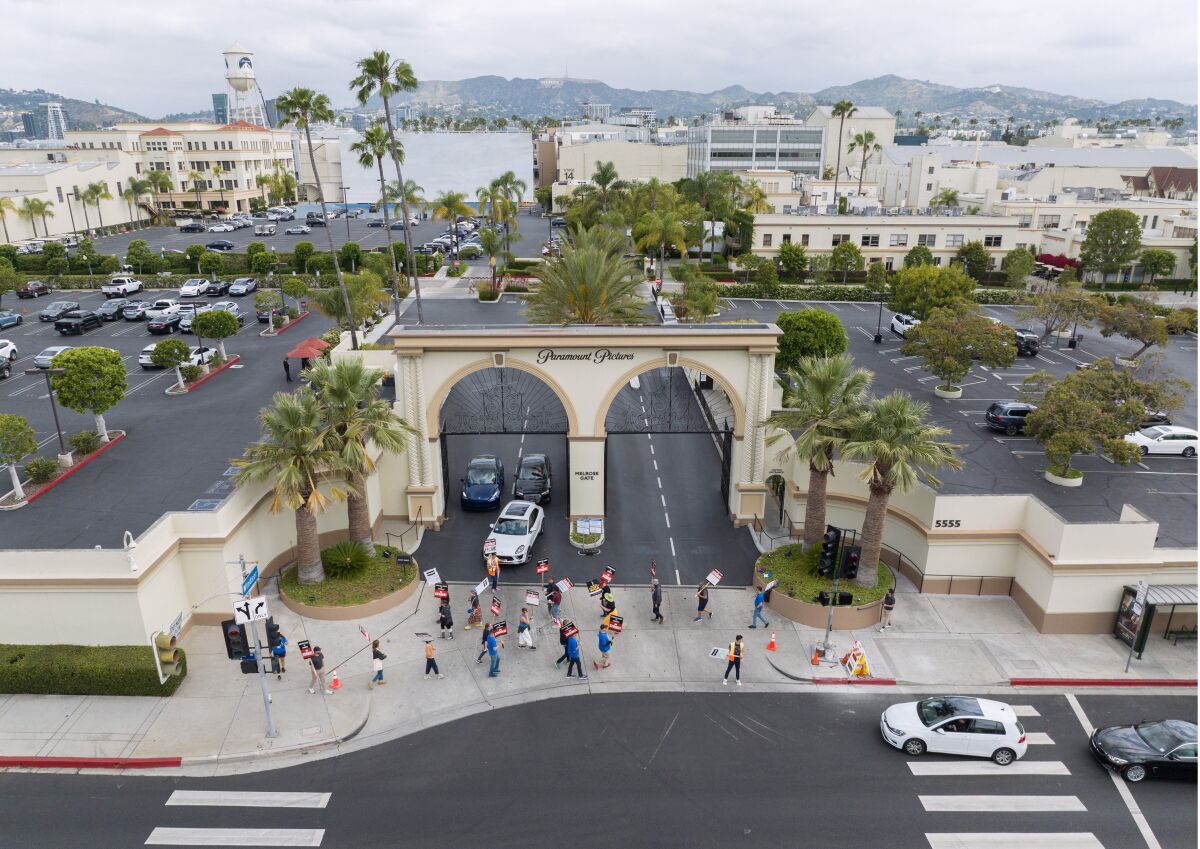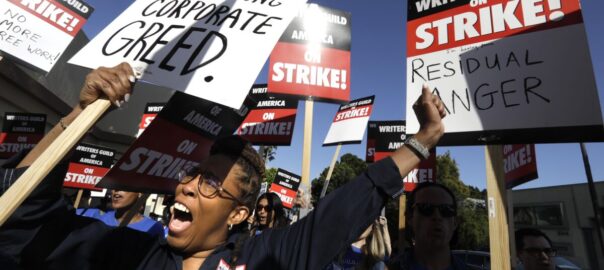[ad_1]

Writers Guild of America members, with support from SAG-AFTRA, strike at Paramount Studios in Los Angeles.
(Myung J. Chun / Los Angeles Times)
Actor Brandon Morgan has been avoiding the Netflix picket line after his WGA friend warned it was “too crazy” and “too high energy.” Instead, three times a week, when he can arrange for childcare, the SAG-AFTRA member has been picketing about one mile south at Paramount Studios. He described it as “friendly” and “relaxed.”
“Striking is kind of hard, man — I mean, I’m in my 40s — but to be out here in the sun, walking, I think I got like 8,000 steps in so far,” Morgan said while on his way to his car. “This is hard work.”
Paramount — the last major studio to operate in Hollywood — is far from the biggest name in streaming. Unlike Netflix, Paramount+ isn’t synonymous with the upending of the Hollywood business model. And here, there are no corporate offices to scream at. Instead, large gates provide a picturesque backdrop for picketing.
It’s common for groups protesting together to catch a selfie in front of the Melrose Gate. “Who doesn’t want a picture in front of those pearly gates?” joked writer-director-actor Nicol Paone, who wrote and directed the 2020 comedy “Friendsgiving,” as she marched at the Netflix picket line.
The studio’s original Bronson Gate — featured in more than a dozen films — is ensconced within Paramount’s private property, protecting it from any picket line social media posts. But it remains visible on a nearby billboard, advertising studio tours at Paramount, showing a young couple holding hands as they walk toward the historic Spanish colonial revivalist archway. “Ready for your close-up,” the ad entices.
With little ground to cover along the Melrose Gate, picketers at Paramount walk at a leisurely pace to the sound of pop hits blaring from portable speakers, such as NSYNC’s “Bye Bye Bye” or Nena’s “99 Red Balloons.” Last week, guilds hosted a karaoke day. Strike captains orchestrate crossings in front of the gate, careful to not obstruct the road. A man in a black SAG-AFTRA shirt served as a de facto “walk” signal, beating his drum whenever strike captains allowed the picket lines to pass.
Though Melrose carries less vehicle traffic than Sunset, honks still come. And occasionally cheers, as a woman who claimed to be an executive producer rolled by yelling in a beat-up sedan, fist shaking in the air, “Don’t give up!”
Catching some shade beneath the gate on a warm afternoon in late July was Dan Aid, an actor and musician who lives nearby. Before the strike, Aid had minor roles on the Showtime comedy “SMILF” and NBC’s crime drama “Good Girls,” and was busy booking auditions and prepping for callbacks. The recent time off has allowed him to find balance in his life, committing more time to his music projects and family. The picket lines have provided a sense of community and belonging with other creatives unlike any other space he’s found since moving to Los Angeles two years ago.
“I love artists, I love creative people, I love getting excited about the new things they’re bringing into the world,” Aid said. “And I think those conversations definitely happen here, more than any place I’ve been to.”
At the Paramount picket line, some of those fellow creative people happen to be celebrities.
One week earlier, Jack Black picketed while in town visiting his father. Black — a SAG-AFTRA member “since before most of these strikers were born” (1983) — marched, posed for photos with younger actors and fielded questions from reporters. Some picketers observed that after Black’s appearance, attendance doubled over the next several days.

The recognizable gate at Paramount Studios serves as a backdrop for the protests.
(Myung J. Chun / Los Angeles Times)
That week, Lance Bass, a member of NYSNC and SAG-AFTRA, bought pizza for protesters. The previous week, Hillary Duff joined the picket line and was seen dancing and singing along to her song “What Dreams Are Made Of” from “The Lizzie McGuire Movie.” And on this particular day in late July, Seth Rogen and Max Greenfield of “New Girl” joined picketers, causing an audible stir among the line, and attracting paparazzi to the studio. Morgan said their presence is important because it “puts people in better spirits.”
The significance of the celebrity presence at the Paramount line isn’t lost on Isa Briones, who marched, for the first time, alongside fellow actor and friend Miles Elliot. The pair marked the moment with selfies at the Melrose Gate, which Briones later posted to Instagram. The daughter of musical theater and screen actor Jon Jon Briones, she had recently landed key roles in the Paramount+ series “Star Trek: Picard” as android Soji and in the upcoming Disney+ “Goosebumps” remake.
“You’re seeing people with very different careers,” Briones said. There are big names like Rogen and Greenfield, and people who “have done some things here and there. But then there are these people who can’t make enough to get health insurance with the rest of everyone. And so all of us are here for the same thing, and all of us are united in this.”
With film production mostly halted due to the strike, the picket lines can also provide a place where performers can do what they do best.
“People who get into these performance industries have a need to be witnessed and seen at the moment they are at in their lives,” Aid said. “That’s why we’re drawn to it, because we need that reflection of ourselves to check in on where we sit in the world.”
The picket lines, Aid said, are a place where creative people can still express themselves.
“You can show up with joy, and you can wear a costume and you can sing and you can dance.”
[ad_2]
Source link
